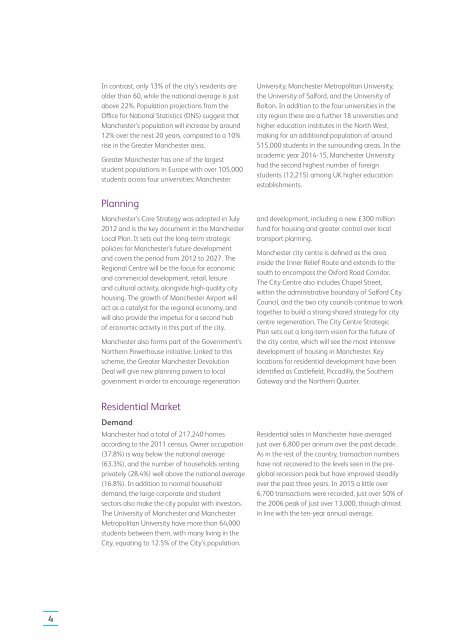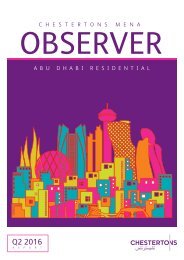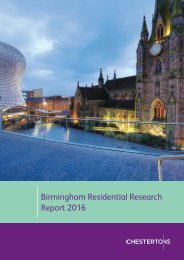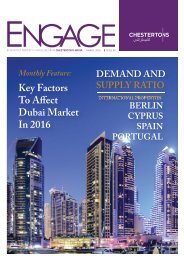Manchester Report
Create successful ePaper yourself
Turn your PDF publications into a flip-book with our unique Google optimized e-Paper software.
In contrast, only 13% of the city’s residents are<br />
older than 60, while the national average is just<br />
above 22%. Population projections from the<br />
Office for National Statistics (ONS) suggest that<br />
<strong>Manchester</strong>’s population will increase by around<br />
12% over the next 20 years, compared to a 10%<br />
rise in the Greater <strong>Manchester</strong> area.<br />
Greater <strong>Manchester</strong> has one of the largest<br />
student populations in Europe with over 105,000<br />
students across four universities: <strong>Manchester</strong><br />
University, <strong>Manchester</strong> Metropolitan University,<br />
the University of Salford, and the University of<br />
Bolton. In addition to the four universities in the<br />
city region there are a further 18 universities and<br />
higher education institutes in the North West,<br />
making for an additional population of around<br />
515,000 students in the surrounding areas. In the<br />
academic year 2014-15, <strong>Manchester</strong> University<br />
had the second highest number of foreign<br />
students (12,215) among UK higher education<br />
establishments.<br />
Planning<br />
<strong>Manchester</strong>’s Core Strategy was adopted in July<br />
2012 and is the key document in the <strong>Manchester</strong><br />
Local Plan. It sets out the long-term strategic<br />
policies for <strong>Manchester</strong>’s future development<br />
and covers the period from 2012 to 2027. The<br />
Regional Centre will be the focus for economic<br />
and commercial development, retail, leisure<br />
and cultural activity, alongside high-quality city<br />
housing. The growth of <strong>Manchester</strong> Airport will<br />
act as a catalyst for the regional economy, and<br />
will also provide the impetus for a second hub<br />
of economic activity in this part of the city.<br />
<strong>Manchester</strong> also forms part of the Government’s<br />
Northern Powerhouse initiative. Linked to this<br />
scheme, the Greater <strong>Manchester</strong> Devolution<br />
Deal will give new planning powers to local<br />
government in order to encourage regeneration<br />
and development, including a new £300 million<br />
fund for housing and greater control over local<br />
transport planning.<br />
<strong>Manchester</strong> city centre is defined as the area<br />
inside the Inner Relief Route and extends to the<br />
south to encompass the Oxford Road Corridor.<br />
The City Centre also includes Chapel Street,<br />
within the administrative boundary of Salford City<br />
Council, and the two city councils continue to work<br />
together to build a strong shared strategy for city<br />
centre regeneration. The City Centre Strategic<br />
Plan sets out a long-term vision for the future of<br />
the city centre, which will see the most intensive<br />
development of housing in <strong>Manchester</strong>. Key<br />
locations for residential development have been<br />
identified as Castlefield, Piccadilly, the Southern<br />
Gateway and the Northern Quarter.<br />
Residential Market<br />
Demand<br />
<strong>Manchester</strong> had a total of 217,240 homes<br />
according to the 2011 census. Owner occupation<br />
(37.8%) is way below the national average<br />
(63.3%), and the number of households renting<br />
privately (28.4%) well above the national average<br />
(16.8%). In addition to normal household<br />
demand, the large corporate and student<br />
sectors also make the city popular with investors.<br />
The University of <strong>Manchester</strong> and <strong>Manchester</strong><br />
Metropolitan University have more than 64,000<br />
students between them, with many living in the<br />
City, equating to 12.5% of the City’s population.<br />
Residential sales in <strong>Manchester</strong> have averaged<br />
just over 6,800 per annum over the past decade.<br />
As in the rest of the country, transaction numbers<br />
have not recovered to the levels seen in the preglobal<br />
recession peak but have improved steadily<br />
over the past three years. In 2015 a little over<br />
6,700 transactions were recorded, just over 50% of<br />
the 2006 peak of just over 13,000, though almost<br />
in line with the ten-year annual average.<br />
4















